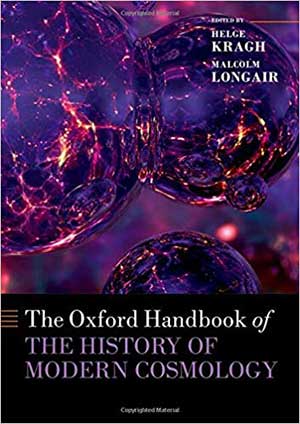Book Review: The Oxford Handbook of the History of Modern Cosmology by Helge Kragh and Malcolm Longair
A valuable addition to the history of cosmology
It is sometimes claimed that cosmology, the study of the universe, is the oldest of the sciences.
However, there is little question that cosmology only became a quantitative science during the 20th century. Following the advent of Einstein’s general theory of relativity and the observation of the first evidence of a universe in expansion, the stage was set for cosmology to emerge as a mature science based on mathematical models combined with astronomical observations and deductions from physical theory.
However, the path from static to expanding cosmologies, and from the discovery of the cosmic microwave background to today’s concordance model of the universe was a route with many twists and turns, false trails and cul de sacs. Thus, the publication by Oxford University Press of a handbook on the history of modern cosmology is a most welcome development. As editors Helge Kragh and Malcolm Longair point out in the preface, there are hundreds of books on the emergence of the Copernican model of the solar system, yet few scholarly accounts of the emergence of today’s model of the universe.

Book: The Oxford Handbook of the History of Modern Cosmology by Helge Kragh and Malcolm Longair (Oxford University Press 2019).
The book comprises thirteen distinct chapters written by an impressive array of astronomers, astrophysicists, cosmologists and historians of science. The chapters can be read as stand-alone articles but are arranged in rough chronological order, from Kragh’s opening article on pre-relativistic models of the universe in the period 1850-1910 to Longair’s paper on the observational and theoretical foundations of today’s ‘Lambda-CDM’ model towards the end of the volume. Along the way, one finds articles on the development of extra-galactic astronomy and the discovery of Hubble’s law (by Robert Smith), on the rise of dynamic relativistic models of the universe in the 1920s (by Matteo Realdi), and on the long debate between expanding and steady-state cosmologies (by Kragh). Other chapters include an article on observational and astrophysical cosmology in the period 1940-1980 (by Longair) and a paper on the discovery of the cosmic microwave background (by Bruce Partridge). Of particular interest to many students, practicing cosmologists and historians will be the chapter (by Longair and Chris Smeenk) on inflation, dark matter, dark energy and other little-understood components of modern cosmology.
Some of the above may sound a little familiar to readers and this is perhaps one slight problem with the handbook. Much of the material in the first half of the volume has already been presented in classic books such as Kragh’s ‘Cosmology and Controversy’ (Princeton University Press 1996), Longair’s ‘The Cosmic Century’ (Cambridge University Press 2006) and the anthology ‘Finding the Big Bang’ (Cambridge University Press 2009) edited by Jim Peebles, Lyman Page and Bruce Partridge.
However, it’s hard to see how a handbook that seeks to provide a reasonably comprehensive history of modern cosmology in one place can avoid some re-working of this material.
With this in mind, I thought it was a pity that the book did not feature a chapter on the sociological history of cosmology, i.e., on the emergence of modern cosmology as a distinct scientific discipline with its own journals, associations, degree programs and reward system. As the editors point out in the preface, the social history of modern cosmology has received almost no scholarly attention and this would have been a valuable original addition to the literature.
A related but perhaps more serious criticism concerns the description of the development of modern theoretical cosmology. While the story of the emergence of dynamic cosmologies in the first decades of the 20th century is well covered in early chapters; this narrative is quite well known. By contrast, there is surprisingly little in later chapters on the chronological development of theoretical cosmology from the 1960s onwards, with only passing descriptions of the key contributions of figures such as Roger Penrose, George Ellis, Robert Dicke, Yakov Zeldovitch and the late Stephen Hawking. It is probably fair to say that the book does not convey a strong sense of the historical development of theoretical cosmology in the second half of the 20th century, or of the manner in which advances in general relativity impacted on cosmology. Indeed, it could be argued that the second half of the book presents a history of cosmology that is quite phenomenonological; this may be due to a surprising lack of theoretical cosmologists amongst the contributors.
However, these are minor quibbles. All in all, this new handbook provides a comprehensive and highly useful history of modern cosmology that many physicists and science historians alike will want on their shelf for reference.
Cormac O’Raifeartaigh lectures in physics at Waterford Institute of Technology and University College Dublin in Ireland. He is a Fellow of the Royal Astronomical Society and a Fellow of the Institute of Physics.
